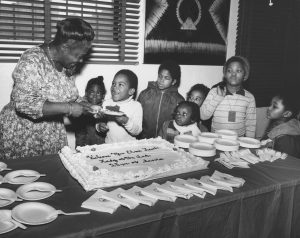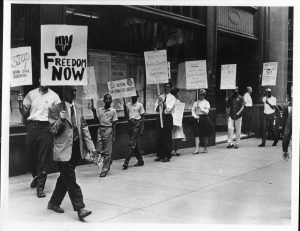The following is a series written by archivists, academics, activists, and educators making available primary source material, providing pedagogical support, and furthering the understanding of Boston Public School’s Desegregation history.
View all posts
 This post was reprinted from Anna Kijas of the Boston College Libraries Digital Scholarship Group: https://ds.bc.edu/visualizing-racial-disparity-in-boston-c-1970/ with permission by Molly Brown, 11/13/2017
This post was reprinted from Anna Kijas of the Boston College Libraries Digital Scholarship Group: https://ds.bc.edu/visualizing-racial-disparity-in-boston-c-1970/ with permission by Molly Brown, 11/13/2017
During the spring and summer of this year, I collaborated on an exhibit,
Desegregating Boston Schools: Crisis and Community Activism, 1963-1977, with
Sarah Melton and
Dr. Eric Weiskott. The main exhibit is at the John J. Burns Library, and a smaller complementary exhibit is on view in the Reading Room, Level 3, Thomas P. O’Neill, Jr. Library. Curating this exhibit required doing research in special collections at John J. Burns Library, specifically in the
Louise Bonar and Carol Wolfe collection,
Citywide Coordinating Council Records, and the
Robert F. Drinan, SJ Congressional Papers.
One aspect of this exhibit was to create visualizations and infographics using racial demographic data for the City of Boston, racial distribution of students within the Boston Public Schools, and outcomes of the Boston School Committee election of 1973. The data for these visualizations was drawn from the materials in the Bonar/Wolfe collection, Citywide Coordinating Council Records, 1970 Census, and
Analyze Boston.
To complement the materials in the exhibit in the John J. Burns Library, which include a
map depicting the total black population in the City of Boston (1970) juxtaposed with the wards won by the only black candidate—Patricia Bonner-Lyons, who ran for the Boston School Committee in 1973—I created these three density maps. The maps were created with tract-level 1970 Census data, which depicts the neighborhoods within the City of Boston as established by the Bureau of the Census. The shading (light to dark) of each neighborhood correlates with the number (low to high) of people according to race, as documented in the 1970 Census. From these visualizations it is easy to see that neighborhoods, including South Boston, West Roxbury, Roslindale, and Jamaica Plain were predominantly white, while the neighborhoods of Roxbury and Dorchester were predominantly black.

Density map depicting population according to racial demographics (white, black, and hispanic) in the City of Boston, ca. 1970. (Click on the image to open the interactive map in separate tab).
There are many different GIS platforms and tools available, but for this project I used
Tableau Public a freely available software that enables you to create interactive data visualizations (not just maps!). The neighborhoods in these maps are created with a
shapefile that I generated from the
Neighborhood Change Database 1970-2010. Tableau Public provides the option to connect a spatial file, which will then allow you to render a spatial visualization and identify the specific dimensions (for this map: population by race) that will be shown in an info box upon clicking or hovering over the map.

Dimensions are visible in the pop-up box.
The full workbook for this visualization can be
downloaded from the “City of Boston 1970 (test)” page on my Tableau Public profile page.
Anna Kijas::
https://wp.me/p8gxJc-k8
https://ds.bc.edu/




